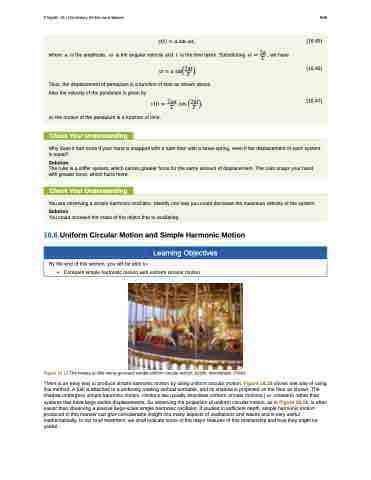Page 711 - College Physics For AP Courses
P. 711
Chapter 16 | Oscillatory Motion and Waves 699
���� � � ��� ���
where � is the amplitude, � is the angular velocity and � is the time taken. Substituting � � �� , we have �
�� � � ����������� �
Thus, the displacement of pendulum is a function of time as shown above. Also the velocity of the pendulum is given by
���� � ��� ��� �������� ��
so the motion of the pendulum is a function of time.
(16.45)
(16.46)
(16.47)
Check Your Understanding
Why does it hurt more if your hand is snapped with a ruler than with a loose spring, even if the displacement of each system is equal?
Solution
The ruler is a stiffer system, which carries greater force for the same amount of displacement. The ruler snaps your hand with greater force, which hurts more.
Check Your Understanding
You are observing a simple harmonic oscillator. Identify one way you could decrease the maximum velocity of the system.
Solution
You could increase the mass of the object that is oscillating.
16.6 Uniform Circular Motion and Simple Harmonic Motion
Figure 16.17 The horses on this merry-go-round exhibit uniform circular motion. (credit: Wonderlane, Flickr)
There is an easy way to produce simple harmonic motion by using uniform circular motion. Figure 16.18 shows one way of using this method. A ball is attached to a uniformly rotating vertical turntable, and its shadow is projected on the floor as shown. The shadow undergoes simple harmonic motion. Hooke’s law usually describes uniform circular motions ( � constant) rather than
systems that have large visible displacements. So observing the projection of uniform circular motion, as in Figure 16.18, is often easier than observing a precise large-scale simple harmonic oscillator. If studied in sufficient depth, simple harmonic motion produced in this manner can give considerable insight into many aspects of oscillations and waves and is very useful mathematically. In our brief treatment, we shall indicate some of the major features of this relationship and how they might be useful.
Learning Objectives
By the end of this section, you will be able to:
• Compare simple harmonic motion with uniform circular motion.


